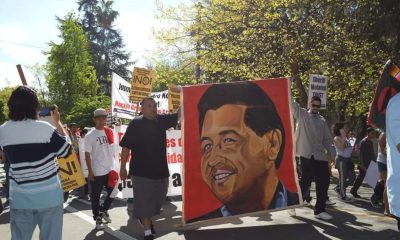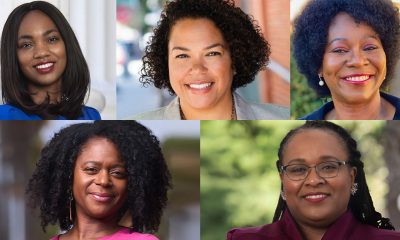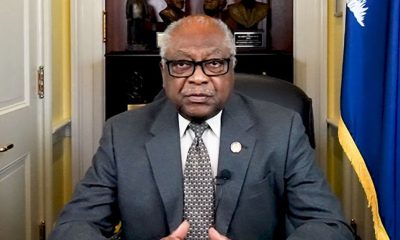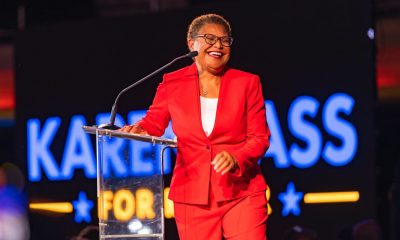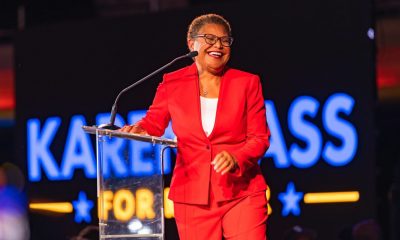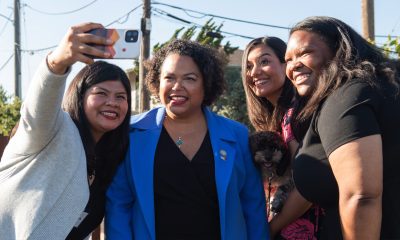Politics
5 Things to Know Before Obama Rolls Out His Budget Monday

In this March 4, 2014 file photo, copies of President Barack Obama’s proposed fiscal 2015 budget are set out for distribution on Capitol Hill in Washington. (AP Photo/J. Scott Applewhite, File)
Connie Cass, ASSOCIATED PRESS
WASHINGTON (AP) — A quick quiz:
Monday is —
a) Groundhog Day
b) Budget Day
c) A day for repeating the same old arguments over spending and taxes, only louder.
d) All of the above.
If you picked “d,” you’re in the proper spirit for federal Budget Day, which appropriately falls on Groundhog Day this year. It’s safe to predict we’re in for way more than six more weeks of Republicans and Democrats fighting over how to spend our money.
Here are five things to know before President Barack Obama’s 2016 budget fully emerges Monday:
___
IT’S JUST AN OPENING BID
Despite all the hoopla surrounding it, a president’s budget is merely a suggestion. That’s especially true this year, with Obama delivering his multi-trillion-dollar wish list to a Senate and House run by the opposition.
The Constitution gives Congress power to decide how to spend taxpayers’ money. After lawmakers get the president’s budget, they’ll set about coming up with their own, very different, spending plan. There’s a hitch, though — their legislation needs Obama’s signature to become law.
If the president and Congress can’t compromise on spending, that’s how we end up with a partial government shutdown. Republican leaders and Obama say they don’t want that to happen this year.
Still, the usual big disputes loom: Obama wants more spending and higher taxes on the wealthy. Most Republicans want to spend less — except on the military — and resist tax increases.
Plus, this year Republicans are promising to use spending bills to attack Obama’s signature health care law and to roll back his order giving some immigrants relief from deportation.
___
OBAMA WILL BID HIGH
The president will call for increasing spending on agency operating budgets by 7 percent next year, blowing through limits set in an earlier bipartisan deal.
Previewing the detailed document to be released Monday, the White House said it would call for spending about $74 billion more next year than the painful automatic cuts Obama signed into law in that 2011 deal commonly known as the “sequester.” Those harsh automatic cuts were originally set in motion as a threat that would force bipartisan agreement to replace them with something more sensible, but it didn’t work.
Obama would roughly divide the extra money he seeks between the military and domestic programs, such as college aid, medical research and child care.
The White House, without giving details yet, says Obama would offset his spending increases by cutting inefficient programs and closing tax loopholes. In that way, he could continue the recent trend of shrinking the nation’s annual budget deficits.
Republicans say that’s no good. They prefer to tackle the deficit by holding domestic spending in check, or trimming even more.
___
A BIG QUESTION: HOW MUCH DOES THE MILITARY GET?
The military brass has been pleading for relief from their automatic spending limits. Many lawmakers in both parties, eyeing terror attacks and trouble spots around the globe, are anxious to help.
Obama’s proposal to raise the defense budget by $38 billon would allow for more ships and fighter jets. By bundling the military increase with more domestic spending, Obama will pressure Republicans eager to boost the military budget to give in to some of his priorities.
Will Republicans insist on holding the line on spending, even if it means the Pentagon has to go without, too? And how far are Democratic lawmakers and Obama willing to go in using national defense as a bargaining chip?
___
DETAILS MATTER
If Congress is sure to reject and redo Obama’s budget proposal, you might wonder: Why does he bother?
For one thing, the law says he has to submit a budget to Congress by the first Monday in February, although Obama has sometimes missed that deadline.
Plus, the federal budget is a big deal. It’s expected to be in the vicinity of $4 trillion — that’s trillion with a “t” — for the fiscal year beginning in October.
It goes much deeper than political rhetoric about ending big government or boosting the middle class.
The budget carries thousands and thousands of decisions about concrete things the government does — like paying park rangers, Border Patrol agents and workers who answer IRS help lines. Spending money for air traffic control, medical research and food inspection. Weeding out ineffective programs and launching new ones that, hopefully, work better.
The exercise has gone awry over the last few years, leading to showdowns and a 2013 shutdown and failure to complete the normal budget process in a gridlocked Congress.
But the budget minutia that federal agencies sweat over and congressional committees are charged with overseeing is what keeps the U.S. government running.
___
MOST OF THE BUDGET IS ON AUTOPILOT
Running federal agencies isn’t even the half of it.
The biggest share of the budget goes to what’s called “mandatory spending” — ongoing payments that don’t need annual approval by Congress. Social Security, Medicare and Medicaid are the biggies. Others include unemployment checks, food stamps and pensions for veterans and government retirees.
To take on the nation’s long-term debt problem, lawmakers and the president would have to deal with these growing costs.
So far, attempts to reach this sort of “grand bargain” have failed, repeatedly.
____
Associated Press writers Josh Lederman and Andrew Taylor contributed to this report.
Follow Connie Cass on Twitter: http://www.twitter.com/ConnieCass.
Copyright 2015 The Associated Press. All rights reserved. This material may not be published, broadcast, rewritten or redistributed.
###
Activism
S.F. Black Leaders Rally to Protest, Discuss ‘Epidemic’ of Racial Slurs Against Black Students in SF Public School System
Parents at the meeting spoke of their children as no longer feeling safe in school because of bullying and discrimination. Parents also said that reported incidents such as racial slurs and intimidation are not dealt with to their satisfaction and feel ignored.

By Carla Thomas
San Francisco’s Third Baptist Church hosted a rally and meeting Sunday to discuss hatred toward African American students of the San Francisco Unified School District (SFUSD).
Rev. Amos C. Brown, president of the San Francisco NAACP and pastor of Third Baptist Church, along with leadership from local civil rights groups, the city’s faith-based community and Black community leadership convened at the church.
“There has been an epidemic of racial slurs and mistreatment of Black children in our public schools in the city,” said Brown. “This will not be tolerated.”
According to civil rights advocate Mattie Scott, students from elementary to high school have reported an extraordinary amount of racial slurs directed at them.
“There is a surge of overt racism in the schools, and our children should not be subjected to this,” said Scott. “Students are in school to learn, develop, and grow, not be hated on,” said Scott. “The parents of the children feel they have not received the support necessary to protect their children.”
Attendees were briefed last Friday in a meeting with SFUSD Superintendent Dr. Matt Wayne.
SFUSD states that their policies protect children and they are not at liberty to publicly discuss the issues to protect the children’s privacy.
Parents at the meeting spoke of their children as no longer feeling safe in school because of bullying and discrimination. Parents also said that reported incidents such as racial slurs and intimidation are not dealt with to their satisfaction and feel ignored.
Some parents said they have removed their students from school while other parents and community leaders called on the removal of the SFUSD superintendent, the firing of certain school principals and the need for more supportive school board members.
Community advocates discussed boycotting the schools and creating Freedom Schools led by Black leaders and educators, reassuring parents that their child’s wellbeing and education are the highest priority and youth are not to be disrupted by racism or policies that don’t support them.
Virginia Marshall, chair of the San Francisco NAACP’s education committee, offered encouragement to the parents and students in attendance while also announcing an upcoming May 14 school board meeting to demand accountability over their mistreatment.
“I’m urging anyone that cares about our students to pack the May 14 school board meeting,” said Marshall.
This resource was supported in whole or in part by funding provided by the State of California, administered by the California State Library via California Black Media as part of the Stop the Hate Program. The program is supported by partnership with California Department of Social Services and the California Commission on Asian and Pacific Islander American Affairs as part of the Stop the Hate program. To report a hate incident or hate crime and get support, go to CA vs Hate.
Alameda County
Board of Supervisors Accepts Certification of Signatures, Will Schedule Recall Election May 14
The Alameda Board of Supervisors unanimously accepted the certification of the results of the valid signatures submitted for the recall of District Attorney Pamela Price on Tuesday evening. The Board will set the election date at a special meeting on May 14. Before the meeting, recall proponents and opponents held separate press conferences to plead their cases to the Board and residents of Alameda County.
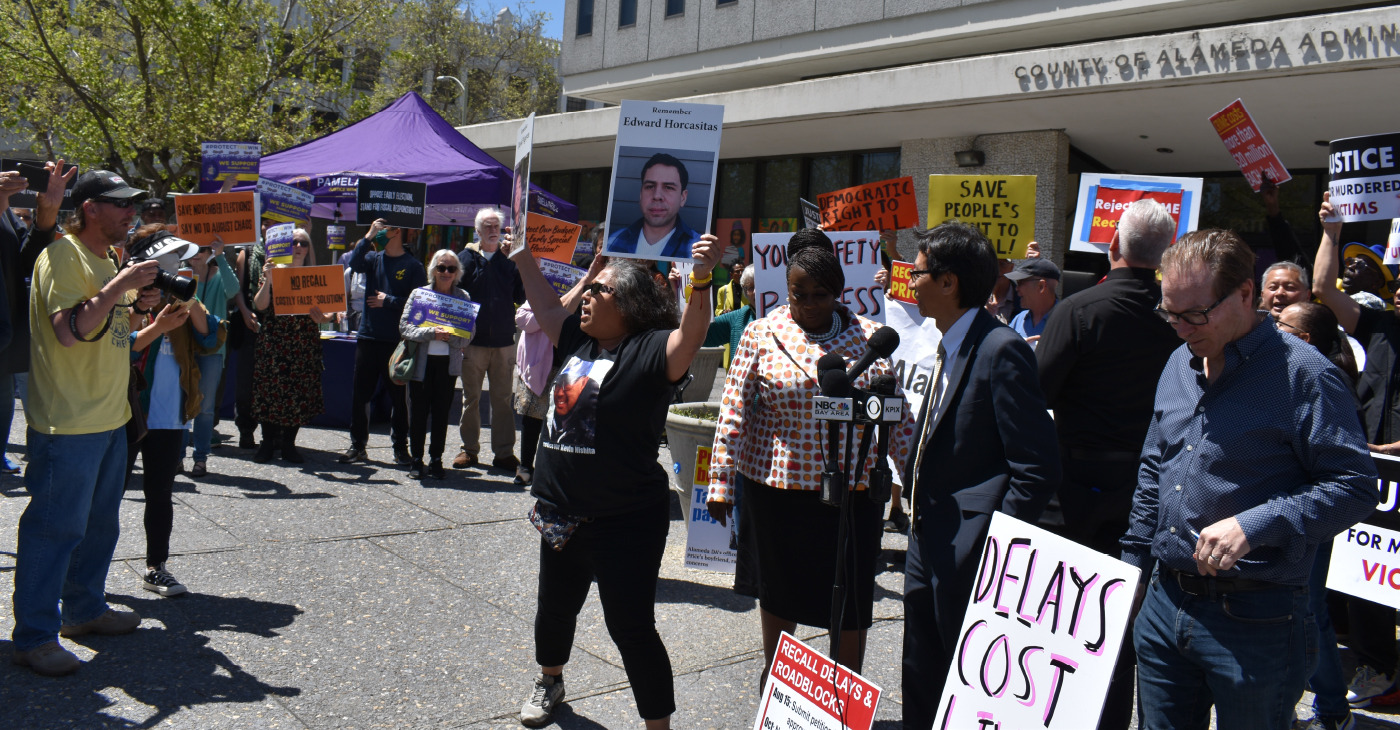
By Magaly Muñoz
The Alameda Board of Supervisors unanimously accepted the certification of the results of the valid signatures submitted for the recall of District Attorney Pamela Price on Tuesday evening. The Board will set the election date at a special meeting on May 14.
Before the meeting, recall proponents and opponents held separate press conferences to plead their cases to the Board and residents of Alameda County.
Price, who up until this point has made little public comment about the recall, held her press conference in Jack London to announce that the California Fair Political Practices Commission has opened an investigation into the finances of the Save Alameda For Everyone (SAFE) recall campaign.
The political action committee (PAC), Reviving the Bay Area, has been the largest contributor to the SAFE organization and has allegedly donated over half a million dollars to the recall efforts.
“Between September 2023 and November 2023, [Revive the Bay Area] donated approximately $578,000 to SAFE without complying with the laws that govern all political committees in California,” Price said.
Price accused the recall campaigns of using irregular signature-gathering processes, such as paying gatherers per signature, and using misleading information to get people to sign their petitions.
SAFE held their own press conference outside of the Alameda County Administration Building at 1221 Oak St. in Oakland, once again calling for the Board to certify their signatures and set a date for the recall election.
Their press conference turned contentious quickly as Price’s “Protect the Win” supporters attempted to yell over the SAFE staff and volunteers. “Stop scapegoating Price” and “Recall Price” chants went on for several moments at a time during this event.
Families of victims urged the Board to think of their loved ones whose lives are worth much more than the millions of dollars that many opponents of the recall say is too much to spend on a special election.
The Registrar of Voters (ROV) estimates the special election could cost anywhere from $15 to $20 million, an amount that is not in their budget.
The Board was presented with several options on when and how to conduct the recall election. They have to set a date no less than 88 days or more than 125 days after May 14, meaning the date could fall anywhere from late July to September.
But the County charter also states that if a general election takes place within 180 days of their scheduling deadline, the Board could choose to use the November ballot as a way to consolidate the two events.
In the event that Price is recalled, the Supervisors would appoint someone to fill the vacancy, though neither the County nor the California charter specifies how long they would have to pick a replacement.
The appointee would serve as district attorney spot until the next election in 2026. Afterwards, either they, if they run and win, or a newly elected candidate would serve the rest of Price’s six-year term until 2029. Price is unique as the only district attorney wo serves a term of six years.
The Board acknowledged that they knew last fall that this recall would come with its own set of complications when Measure B, which changed the local recall charter to match California’s, was first brought to their consideration.
Supervisors Nate Miley and David Haubert opposed discussing the measure, stating that the public would think that the Board was attempting to influence the recall campaign that had already taken off months prior.
“I think ultimately this feels like it’s going to end up in court, one way or the other, depending on who files what,” Haubert said.
Price’s legal team told the Post that the district attorney intended to consider all legal options should the recall election take place.
Miley stated that while he was in support of the amendment to the charter, he did not think it was right to schedule it for the March ballot as it would ultimately cause confusion for everyone involved.
“It has produced some legal entanglements that I think, potentially, could’ve been avoided,” Miley said.
Commentary
Opinion: Lessons for Current Student Protesters From a San Francisco State Strike Veteran
How the nation’s first College of Ethnic studies came about, bringing together Latino, African American and Asian American disciplines may offer some clues as to how to ease the current turmoil on American college campuses over the Israel-Hamas war. After the deadline passed to end the Columbia University encampment by 2 p.m. Monday, student protesters blockaded and occupied Hamilton Hall in a symbolic move early Tuesday morning. Protesters did the same in 1968.

By Emil Guillermo
How the nation’s first College of Ethnic studies came about, bringing together Latino, African American and Asian American disciplines may offer some clues as to how to ease the current turmoil on American college campuses over the Israel-Hamas war.
After the deadline passed to end the Columbia University encampment by 2 p.m. Monday, student protesters blockaded and occupied Hamilton Hall in a symbolic move early Tuesday morning.
Protesters did the same in 1968.
That made me think of San Francisco State University, 1968.
The news was filled with call backs to practically every student protest in the past six decades as arrests mounted into hundreds on nearly two dozen campuses around the country.
In 1970, the protests at Kent State were over the Vietnam War. Ohio National Guardsmen came in, opened fire, and killed four students.
Less than two weeks later that year, civil rights activists outside a dormitory at Jackson State were confronted by armed police. Two African American students were killed, twelve injured.
But again, I didn’t hear anyone mention San Francisco State University, 1968.
That protest addressed all the issues of the day and more. The student strike at SFSU was against the Vietnam war.
That final goal was eventually achieved, but there was violence, sparked mostly by “outside agitators,” who were confronted by police.
“People used the term ‘off the pigs’ but it was more rally rhetoric than a call to action (to actually kill police),” said Daniel Phil Gonzales, who was one of the strikers in 1968.
Gonzales, known as the go-to resource among Filipino American scholars for decades, went on to teach at what was the positive outcome of the strike, San Francisco State University’s College of Ethnic Studies. It’s believed to be the first of its kind in the nation. Gonzales recently retired after more than 50 years as professor.
As for today’s protests, Gonzales is dismayed that the students have constantly dealt with charges of antisemitism.
“It stymies conversation and encourages further polarization and the possibility of violent confrontation,” he said. “You’re going to be labeled pro-Hamas or pro-terrorist.”
That’s happening now. But we forget we are dealing not with Hamas proxies. We are dealing with students.
Gonzales said that was a key lesson at SF State’s strike. The main coalition driving the strike was aided by self-policing from inside of the movement. “That’s very difficult to maintain. Once you start this kind of activity, you don’t know who’s going to join,” he said.
Gonzales believes that in the current situation, there is a patch of humanity, common ground, where one can be both pro-Palestine and pro-Israel. He said it’s made difficult if you stand against the belligerent policies of Benjamin Netanyahu. In that case, you’re likely to be labeled antisemitic.
Despite that, Gonzales is in solidarity with the protesters and the people of Gaza, generally. Not Hamas. And he sees how most of the young people protesting are in shock at what he called the “duration of the absolute inhumane kind of persecution and prosecution of the Palestinians carried out by the Israeli government.”
As a survivor of campus protest decades ago, Gonzales offered some advice to the student protesters of 2024.
“You have to have a definable goal, but right now the path to that goal is unclear,” he said.
About the Author
Emil Guillermo is a journalist and commentator. A veteran newsman in TV and print, he is a former host of NPR’s “All Things Considered.”
-

 Community3 weeks ago
Community3 weeks agoFinancial Assistance Bill for Descendants of Enslaved Persons to Help Them Purchase, Own, or Maintain a Home
-

 Business3 weeks ago
Business3 weeks agoV.P. Kamala Harris: Americans With Criminal Records Will Soon Be Eligible for SBA Loans
-

 City Government4 days ago
City Government4 days agoCourt Throws Out Law That Allowed Californians to Build Duplexes, Triplexes and RDUs on Their Properties
-

 Activism4 weeks ago
Activism4 weeks agoOakland Post: Week of April 10 – 16, 2024
-

 Activism2 weeks ago
Activism2 weeks agoOakland Post: Week of April 24 – 30, 2024
-

 Community3 weeks ago
Community3 weeks agoAG Bonta Says Oakland School Leaders Should Comply with State Laws to Avoid ‘Disparate Harm’ When Closing or Merging Schools
-

 Community3 weeks ago
Community3 weeks agoRichmond Nonprofit Helps Ex-Felons Get Back on Their Feet
-

 Community3 weeks ago
Community3 weeks agoOakland WNBA Player to be Inducted Into Hall of Fame


